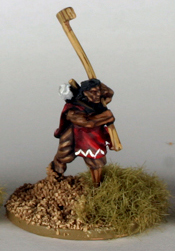
Mapuche Warrior with Longquilquil.
|
The Inca conquered all the peoples of South America they confronted using a combination of martial prowess and organisational skill. All but one, that is, for to their south lay a people whose refusal to bend their knee to a conqueror was absolute. The Inca simply called these people "the enemy" or "the warriors." When the Spanish arrived, and ventured toward that same southern border of the former Inca Empire, they discovered these "enemies" -- the Mapuche tribes, the most formidable people the Spanish confronted anywhere in the New World.
Indomitable and resourceful, willing to adopt the weaponry of their foes, the Mapuche led many a campaign in which they outmanoeuvred and outfought the stunned Spaniards. Knowing the terror the Spaniards had of cannibalism, they adopted the practice just to terrify their European foes, and many a Spanish commander was not only defeated, but consumed as well. When the Mapuche found Spanish weaponry and tactics to be difficult to defeat on the open field, they simply adopted them wholesale, with ruthless efficiency, including close order pike tactics and mounted warfare. Firearms were too difficult to manufacture but the Mapuche continued to use the bow, and some archers also used the dreaded longoquilquil, a very long hardwood club superficially resembling a hockey stick which they used to pull men from horseback and then pummel on the ground. Soon Europeans were marvelling at the close order and discipline of the Mapuche pikemen, who fought "as crowded as Germans," and by the seventeenth century their mounted arm was not only able to fight Spanish cavalry on the open field, but to defeat them.
It wasn't at all uncommon for the Mapuche tribes to field armies of 10,000 men or more. Woodcuttings from the period show the Mapuche armies drawn up in the same regular, tight formations as their Spanish foes.
This line represents the Mapuche at the full development of their reform tactics, in the very late 16th to 17th centuries. Their dress had changed radically by then to adopt to equestrian life -- because many or even all Mapuche now rode to battle (although most dismounted to fight), they had taken to wearing a type of shorts rather than a tunic. Warriors frequently added a local variation on a poncho, although men just as often fought barechested. A few of our models also wear "liberated" Spanish armour, morions or breastplates, or imitation armour made locally of leather. However, the mounted commander, who can represent either a Lonco (chieftain) or a Toqui (warlord), is heavily equipped with both a morion and a breastplate, as well as a ceremonial axe of command.
It took the development of the machine gun in the late 19th century for the successors of the Spaniards, the Chilean Army, to fully pacify this remarkable people. So get ready to game with an indigenous people that regularly conquered the "conquerors!" Models sculpted by Mike Broadbent. Ian Heath's Armies of the 16th Century was a reference for the above summary and is a highly recommended source for these warlike tribesmen.
|

